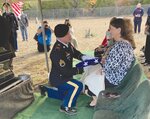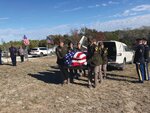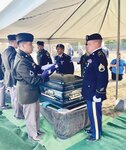



Seventy-eight years ago, when Gatesville native Robert Green Rudd was killed during the Battle of the Bulge during World War II, it was not believed that his body would ever be located, identified, or returned to his native Texas. Since his death in 1945, the advancement of forensic research has allowed DNA testing to answer many unsolved mysteries and to identify unknown remains.
After seven decades, Staff Sergeant Robert Rudd was identified through the use of dental, anthropological, and DNA analysis.
On April 12, 1942, Rudd enlisted in the U.S. Army. In the early fall of 1944, Rudd was assigned to serve with Company C, 28th Infantry Regiment 2D Infantry Division during World War II. During an attack on the enemy forces along Germany’s west border, Rudd’s Infantry Division became concentrated around Elsenborn, Belgium. Toward the end of January 1945, Rudd’s battalions secured ground near Wirtzfeld and moved on to the towns of Rocherath-Krinkelt where they encountered fierce battles. It was sometime during the fighting on Rocherath that Staff Sergeant Robert Rudd was killed. Due to major restrictions in the area, his body was not immediately recovered.
Seven sets of human remains were later discovered by Belgian residents in the Elsenbuchel Forest. Of the remains, all were identified except for one, which was at that time given the coding title of X-3144.
In 1946, the American Graves Registration Command became in charge of recovering and identifying remains in the European Theatre. During the following years, family requests were made to compare the remains of an unknown to that of Rudd.
Last week, his body was returned to Texas after being buried as an “unknown soldier” at the Ardennes American Cemetery in Belgium for 78 years. His niece, Jane Olivier, described the minute that the plane carrying his remains touched down at the Austin-Bergstrom International Airport. She said that the airport came to a standstill when the plane began to taxi toward the terminal. She said that jets of water on either side of the runway created an arch for the plane to pass beneath in honor of a soldier who gave his life for his country so many years before. When the remains of fallen soldiers are returned home, it is customary for two fire trucks to create the arch as a sign of respect and gratitude.
“It was the most serene moment watching the plane taxi to the gate, and I will never forget that the pilots came to us to pay their respects. It was amazing,” Olivier said.
Fort Cavazos granted special permission to open the closed Bethel Cemetery for Rudd’s burial. The graveside funeral was conducted with full military honors. “I am so thankful that they could bring him here where his parents are buried, and that the military would open this cemetery again for his burial,” Olivier said.
Olivier was one of five surviving family members in attendance at the service to honor her uncle. Several dozen veterans were also present at the service who paid their respects to Sgt. Rudd and his family. Teri Olivier, daughter of Jane Olivier, said, “When we drove up, there were so many more people here than were even in the procession, and it was incredibly moving.”
Chaplain Maj. Matt Burden with the 1st Cavalry Division presided over the ceremony and stated, “After his death, his family was presented with the Bronze Star and the Purple Heart for his heroism as he gave his life for his country, the ultimate price any soldier has to give.”
Following the service, one attendee walked up to Sgt. Rudd’s casket and uttered two words that were in the hearts of all who were there, “Welcome Home.”